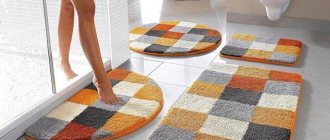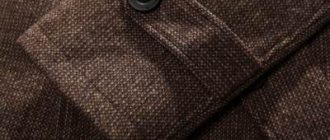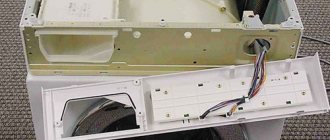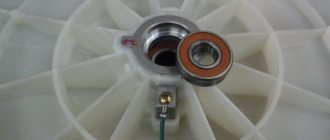08/31/201602.10.2020 Maria Ivanova
Have you taken up exercise or gone on a diet and lost weight? Have you had a baby and lost weight? You may be wondering how to wash a thing so that it shrinks? Each fabric has its own optimal temperature regime. When you turn up the temperature and then plunge things into ice water, most things will shrink.
Not everyone has the opportunity to completely update their wardrobe. In addition, woolen, cotton, and silk items shrink well after washing. Only polyester and other synthetics do not shrink.
Manufacturers write on the label at what temperature to wash this or that item. If it is not there, try to determine on your own what fabric the item is made of.
If that doesn’t work, ask the salesperson in the fabric sales department or atelier. Based on this knowledge, you can act by washing the item at a certain temperature so that a sweater, for example, made of wool, does not become dry.
When you wash linen and other fabrics, it is important to choose the right powder. It should be for colored things to make them even juicier. Then your clothes will not lose their former luster and will be like new.
- 1 Methods 1.1 Option No. 1
- 1.2 Option No. 2
- 1.3 Option No. 3
Let's figure out how to make clothes made of cotton, synthetics or denim shrink
As a rule, we can’t stand it when purchased new clothes fit like a glove when we try them on, fit both in length and width, but after the first wash they jump up by two or three centimeters, so that the item can no longer be worn. This happens especially often with cotton products. But there are situations on the contrary, when it is necessary to shrink the clothes a little, to “conjure” them so that they shrink. How can you downsize cotton, denim or polyester textiles to get your favorite clothes that fit perfectly?
What to do with knitted items
Hand-knitted items require delicate care. If the knitting has stretched over time, this problem can be eliminated.
Temperature difference
In order for a knitted item to return to its previous size, you need to soak the item in boiling water for 10 minutes. After this, the knitted product is placed in a cold place and left for 10 minutes, after which it is rinsed in warm water. This effect will reduce the density of the fibers.
Steaming with an iron
Using an iron, you can reduce a wool item by one size. To do this, the product is laid out on an ironing board, sprayed with water and, using steam, thoroughly ironed.
How to reduce width, not length
Very often knitted items stretch in width. In order to resolve this problem, you must perform the following procedure:
- After washing, spread the wet item on a towel to dry;
- using pins, give the product the required width and pin it to the towel;
- Correct the width every 30 minutes; the procedure is carried out until the product is completely dry.
Using this method will correct the width of the product by one size.
Correction of individual elongated sections
A very common problem that wool owners may encounter is stretched parts such as elbows or knees. To fix this problem you need to:
- spread the product on the ironing board;
- pour water into a spray bottle and spray the desired area;
- iron until completely dry.
The same result can be achieved using an iron with steam function.
How to restore stretched sleeves
In order to fix stretched sleeves on a sweater, you need to perform the following algorithm of actions. In order to return the shape to the sleeves, you need to:
- boil water in a basin;
- lower the sleeves one by one into boiling water for 5 minutes;
- Lay the sweater on a towel and leave until completely cool.
The effect of this procedure lasts for several weeks, after which the procedure must be repeated.
Proper washing strategy
WERAYUTH TESSRIMUANG/GETTY IMAGES
To keep your clothes looking like new, you need to choose the appropriate washing mode for them. The most important thing is to wash things so as not to damage them. In most cases, the art of proper washing involves preventing any potential shrinkage of clothing. After all, shrinkage of clothing items is one of the most common consequences of improper washing.
But sometimes there are exceptions: when going down a clothing size is exactly what you want to achieve.
see also
Big wash: how often should you wash clothes
? This may be necessary, for example:
- if you accidentally purchased clothes that didn’t fit in an online store or grabbed the latest branded item on sale that had long been the ultimate dream of yours, only it turned out to be a size or two too big;
- Or perhaps you've recently lost weight, but you don't have the desire to spend money on creating a whole new wardrobe.
You may have the idea to slightly shrink something that is too big by shrinking the fabric. This can be done by washing the clothes in hot water and drying them in a dryer at high temperatures, and also steaming them with a hot iron.
However, before you try to downsize a garment, it's important to understand why and how it shrinks, otherwise you could accidentally shrink your favorite T-shirt down to doll size, ruin the soft and bouncy texture of your sweater, and end up with a warped and strange-looking item whose sole purpose - to be a wuss.
Advice on fiber composition and proper laundering comes from one of the nation's leading laundry experts, Mary Gagliardi, aka "Dr. Laundry," a staff scientist and cleaning expert at Clorox, a global manufacturer of consumer detergents and cleaning products. The expert tells you everything you need to know about how to properly and safely shrink clothes made from different fibers.
Why does shrinkage occur?
The main reason for shrinkage is the peculiarities of fabric production. During creation, the fabric is deliberately stretched, and during washing the material tries to regain its optimal shape, as a result of which its length and width decrease. If the threads (warp or weft) have been twisted or compressed too much, when wet they will try to straighten out, but this will happen by shortening the threads that run either across or along the fabric. Another common cause of shrinkage is fiber swelling. In this case, the threads become thicker and shorter.
Fiber type
textileschool.com
According to Mary Gagliardi, fiber type has a big impact on potential shrinkage.
- Fibers that absorb moisture easily, such as cotton and wool, are more prone to shrinkage.
- On the other hand, synthetics are hydrophobic (repel water) and are much less prone to shrinkage.
see also
How to best care for sportswear
How to wash terry products?
Terry robes and towels should not be washed at very high speeds (no more than 800 rpm). This fabric absorbs water well and can lose its softness and fluffiness if you turn on the spin cycle at too high a speed. In addition, the loops on the product can be pulled out as a result of friction against the drum of the washing machine, so when washing such items it is better to fill the drum at least 2/3 full. In order for terry products to retain their basic qualities, they must be rinsed well.
Fiber tension
woodiesclothing.com
Another factor that can contribute to shrinkage is the degree of tension in the yarn fibers when the fabric is woven or knitted. Fiber that is highly stretched during fabric making will shrink in size when wet unless a special finish is applied during the manufacturing process to prevent this effect. In addition, how tightly the fabric is stretched during processing will later be reflected in shrinkage. As with yarn, fabric that is under tension during production will relax when wet. This process is called relaxation shrinkage, Gagliardi says.
During production, a finish can be applied to the fabric to reduce the effects of tension. In general, if a garment has any relaxation shrinkage, you will see most of it the first time you wash it. In other words, if clothes shrink a lot after washing, this means that the fabric used to sew them was not subjected to special anti-shrink treatment during production.
see also
How to keep clothes looking presentable after washing
Decorating fabrics before cutting
Decatting is a wet-heat treatment of fabrics to shrink them before cutting the product. All fabrics that contain 50 percent or more natural fibers are decatified. These are wool, linen, cotton, hemp, silk, and rayon fabrics. If the product that you plan to sew will be washed, decating is required. If you plan to dry clean (coats, suits), simply iron and steam the fabric.
Before cutting, interlining fabrics are soaked and dried, carefully aligned, but not ironed.
Cotton and linen fabrics are soaked, dried and ironed slightly damp. The silk is soaked and dried. Do not iron with a hot iron. Silk fabrics that may fade are moistened by using a damp sheet in which the silk fabric is wrapped before ironing. Plain silk fabrics are ironed without steam on the reverse side to avoid stains.
For woolen fabrics, moisten the underside with a sprayer. After 8-12 hours folded, the fabric is ironed from the inside out. Thin woolen and wool-blend fabrics simply need to be ironed through a damp cloth.
Quality of clothes
www.liveabout.com
The higher the quality of the clothing, the less likely it is to shrink. Special finishes and manufacturing technologies that prevent shrinkage are more often used by higher-end manufacturers who care about product quality. Because most people don't want their clothes to shrink, Gagliardi notes. Customers want to be able to wash their clothes over and over again and keep wearing them, and for them to continue to look the same as when they bought them.
Universal method
This method can be used for both cotton clothing and other popular fabrics. It is characterized by variable temperature.
For controlled shrinkage, use only clean clothing - before downsizing, wash clothing to remove any blood, juice or dirt according to manufacturer's recommendations. Pour the hottest possible water into the pre-prepared washbasin, almost boiling water is acceptable. Wait for the water to cool completely, then take it and squeeze it out a little. Now pour enough cold water into the bowl so that there is sure to be ice at the bottom. The product is again completely immersed in cold water for 15-30 minutes. After the time has passed, take them out, squeeze them a little to get rid of excess moisture, place them on a clean, dry towel and smooth out the folds. Let the fabric dry completely.
This method allows you to wash clothes in such a way that they become several values smaller. It is not suitable for the wardrobe for clothes made of thin and expensive fabric (dresses, expensive shirts and trousers), as well as for things that are inconvenient to soak in a container of water.
How to shrink clothes
home.howstuffworks.com
Regardless of the type of clothing - cotton or denim shirts, hoodies, trousers or jeans, or the fabric - from viscose to 100 percent cotton, the most common process that causes potential shrinkage of clothing is machine washing in hot water and machine drying on high heat. heating
- The hotter the water and the higher the temperature in the dryer, the more the shrinkage rate of any item of clothing that has not been treated during manufacture with special means to prevent shrinkage or shrinkage of the fibers will increase.
This is just one of the reasons why it is important to use water at the optimal temperature when washing. However, higher dryer temperatures can not only cause your clothes to shrink, but also promote fading and damage to the surface of the fabric, usually in the form of creases and tears.
Unfortunately, when it comes to intentionally shrinking clothing, you won't always be successful. For example, if you buy a pair of pants that are too big for you and hope to shrink them a size or two, they may end up getting misshapen. Although washing and drying your trousers at high temperatures can shorten them in length and reduce the waistband, their width may not change at all. This is due to the fact that the cross thread (weft), which runs across the width of the fabric, is much less prone to shrinkage than the warp thread, which runs along the entire length of the fabric. Garments shrink along the length and at the waist because these pieces are usually cut lengthwise along the fabric, the expert says.
see also
How to wash a wool sweater (without ruining it)
To make jeans fit
Remember that shrunken jeans will become shorter. If you need to shrink your jeans, wash them at maximum temperature in the washing machine using the highest speed setting. With this exposure, the fabric fades a little. We do not recommend shrinking different colored jeans at the same time.
Having figured out what water to wash in, let’s look at the drying options:
- Take advantage of the built-in tumble dryer.
- Place the jeans on a hot surface.
- Hang to dry in front of an open oven.
How to shrink cotton
WERAYUTH TESSRIMUANG/GETTY IMAGES
Cotton items shrink best . Cotton is a machine washable fiber that is more likely to shrink under the standard process of washing on a hot cycle followed by a high heat cycle in the dryer. However, finishes applied during production can limit shrinkage, Gagliardi says. The best you can do is try to take advantage of the relaxation shrinkage effect - cotton fibers and yarns have some difficulty getting wet. But even this process has its limits.
Relaxation shrinkage is usually reversed. Remember: when you put on your pants immediately after washing, the belt fits snugly around your waist. But when some time passes, it stretches again - the tension is restored. This effect is clearly visible in the example of jeans, which after washing fit tightly, and then become loose during wear. Tension is the stretching of the waist to the desired size. The pattern pieces for the waistband and legs are cut in the warp (length of the fabric) direction, which tends to weaken more than the weft (width) direction.
So while some items become shorter when machine washed and dried, they do not become narrower. This means that the item can only be shrunk along the length, but in the width it will most likely remain wide or narrow minimally.
Wool sweaters
It’s very easy to make something like this a couple sizes smaller. But there are some nuances here. It is important not to overdo it, otherwise the product will decrease by 3 or even 4 sizes. Even a child cannot wear these clothes.
How to wash a knitted item so that it shrinks, and do it correctly? A knitted sweater should only be washed by hand. It will shrink too much in the machine. You can reduce a knitted dress to the desired size as follows:
- Soak in water at a temperature 20°C higher than indicated on the label. The product must lie in the basin for at least 20 minutes. Afterwards you need to wash the knitted item and rinse the product with cool water. Dry on a towel;
- You can also make a knitted item smaller using a regular indoor battery. The product must be wetted and placed on the radiator to dry.
How to wash a knitted item so that it shrinks for sure? Temperature changes will help. Knitted clothes will quickly shrink to the desired size. After contrast washing and rinsing, the item should be spread on a towel. Such clothes shrink when temperatures change right before your eyes.
Washing in a machine on a gentle cycle will help reduce a woolen item by a couple of sizes. In this case, the temperature needs to be increased by 10-20 degrees, and the spin should be carried out at 500-700 rpm. The product should be rinsed correctly at low temperatures with the addition of wool conditioner.
How to shrink denim (denim)
thejeansblog.com
see also
How to remove price tag or label glue from clothes without damaging it
Denim, or denim , is the same as cotton, only made from coarser fibers and with a tighter weave. If you are going to shrink denim, you can wash and dry it in a washer and dryer. But not all denim fits reliably, especially in width, reminds a laundry expert.
There is one exception: Levi's Shrink-To-Fit 501 jeans, which are designed to change size in the wash. Jeans of this brand are specially purchased two sizes larger, then soaked, and after drying they acquire the desired size. When they are sewn, the manufacturing steps that would normally prevent or limit shrinkage are omitted, so these jeans will shrink completely afterwards. But even these jeans, if you buy them larger than the recommended size, will not shrink more than the manufacturer suggests.
Is it better to use hand or machine wash?
Washing by hand allows you to control not only the size of the item being reduced, but also better preserves the color of the material from which it is made. This is the reason why hand washing is more desirable.
For some fabrics that easily withstand mechanical stress, such as synthetics, it is better to shrink them using a washing machine. This will help maintain strength and be effective.
How to shrink polyester
stylecraze.com
Synthetic fibers such as polyester are much less prone to shrinkage because synthetics, unlike cotton, do not "relax" in the same way as natural fibers. Machine washing and drying may cause some lengthwise shrinkage, Gagliardi says, but there's no way to make an item shrink all the way to size. Moreover, washing and drying in hot water can damage synthetics, and the item will be irrevocably damaged.
see also
How to independently widen jeans and trousers at the waist (without needles and threads)
How to reduce knitwear
Viscose, which is found in knitwear, is considered a popular type of fabric that can be used to make a variety of products. However, very often knitted products stretch and lose their shape. In order to return things to the required size, the following methods can be used:
- study the information indicated on the tag;
- pour water into a basin that is 10 degrees higher than the value on the tag;
- place the cloth there and leave for 20 minutes;
- Wring out the clothes and spread them on a towel until completely dry.
See also
How to hang a TV on a plasterboard wall with your own hands, types of mounts and step-by-step instructions
In order for things to quickly get the required shape, you can speed up drying using a hairdryer or a hot radiator.
Caring for deformable items
After shrinking and subsequent stretching, the item requires more careful care than before.
Recommendations:
- give preference to hand washing;
- use only cold water;
- choose a detergent suitable for the material;
- during the procedure, do not rub things, but simply gently dip them in water;
- do not twist the product, but simply blot it with a towel;
- dry only in a horizontal position in natural conditions;
- Try to iron things as little as possible, and if ironing is required, iron through gauze without the steam function.
Of course, it is better to prevent things from shrinking than to fix this problem later. To do this, simply follow the prescribed instructions for caring for delicate materials. If the product does shrink, you can return its size using mechanical influences and available means.
How to remove stains?
Minor surface contamination can be removed using:
- Soap solution . The composition is applied to the area of contamination and the fabric is lightly wiped with a soft sponge, after which it is washed in warm water;
- Salt. Cover the stain with salt and leave for 20-30 minutes. After cleaning, the item is washed and treated with rinse aid;
- Boric acid . To remove stains, use a 10% solution, which is applied in a small amount to the area of fabric at the site of contamination;
- Citric acid . The cleaning solution is prepared in proportions - 1 tsp. citric acid per 200 ml of water. Use the resulting mixture to wipe the contaminated area and rinse the item in cool water before washing.
The special structure of the fabric fibers makes it not prone to dirt penetration, making difficult-to-remove stains on this type of material a rare exception.
How to stretch a shrunken item
If your favorite wardrobe item shrinks after washing, it can still be saved. You can stretch clothes in several ways using available materials.
Water
The first and most accessible method you can use is stretching with water. For this:
- Soak the item in cool water for 10-15 minutes, allowing the liquid to completely absorb into the threads.
- Remove and, without twisting, squeeze with a towel.
- Lay out a large towel on a horizontal surface and place the item on top.
- During the drying period, stretch the material from time to time and replace the towel with new ones.
Do not use heat sources for drying during the procedure, otherwise all the work will be done in vain.
Iron
This procedure is not suitable for knitted items made from natural or synthetic threads.
Operating procedure:
- Wet the item with cold water.
- Let the water drain and place it on the ironing board.
- Pull the material in the desired directions.
- Set the iron to low or medium heat.
- Iron the material with maximum effort while simultaneously stretching the fabric.
- Turn the product inside out and repeat the procedure.
After ironing, lay the clothing on a towel or sheet, pull the fabric again and press down the edges with a weight. Leave the item to air dry.
Hydrogen peroxide
Hydrogen peroxide is not only an excellent antiseptic. The substance will help return shrunken clothes to their previous shape.
Mode of application:
- Dissolve 50 ml of peroxide in 8-10 liters of cold water.
- Soak the product for half an hour.
- Carefully remove the item and wring it out with a towel.
- Hang clothes on hangers to dry.
During the drying process, come up and stretch the item from time to time, giving it the correct shape.
Ammonia
Ammonia with vodka and turpentine will help make the material more elastic.
Dissolve 100 ml of ammonia, 40–50 ml of turpentine and the same amount of vodka in 10 liters of water. Soak the product in the solution for 60 minutes. After processing, try stretching the item.
Steam stretching
Please note that this method is not suitable for items made of 100% wool.
Operating procedure:
- Soak the clothes in water and wait until all the threads are saturated with liquid.
- Allow excess water to drain.
- Squeeze just a little with gentle movements.
- Lay the item out on a horizontal surface.
- Set the iron to steam function.
- Cover the material with gauze or cotton cloth.
- Gently iron the surface while stretching the fabric.
- Carry out this procedure until the item is completely dry.
An excellent replacement for an iron would be a special steam generator.
Cold stretch
This procedure will save your favorite item from shrinking. First, soak your clothes in soapy water and a detergent suitable for the type of material. Keep the item in the water for at least half an hour, then rinse and wring out with a towel. Roll up wet clothes and pack them in a bag. Place the bag in the freezer for 24 hours. After this time, remove the item and dry it as usual in the fresh air.
Milk
A milk-based solution is suitable for treating white cotton items.
Mix a little milk with cool water and soak the item in the solution for half an hour. Afterwards, rinse the item in clean water, wring it out, pat dry with a towel, and lay it out to dry on a horizontal surface.
Vinegar
Since vinegar is acidic, use it only diluted. Mix one part vinegar with two parts room temperature water. Soak in the liquid for 30 minutes and then stretch.
Soda and tartaric acid
Processing is carried out in 2 approaches.
At the first stage, dissolve soda in cool water at the rate of 10 g per liter of liquid. Soak the product for approximately 12 hours. After treatment, wash by hand using a suitable product.
At the second stage, prepare a solution of tartaric acid and water at the rate of 5 teaspoons of the substance per 1 liter of liquid. Soak the item in the solution for 2 hours. After this, let the water drain, squeeze lightly without twisting, and dry in a manner appropriate for the type of material.
Hair conditioner
Such products soften hair well, so they are also perfect as a “stretcher” for natural materials.
Procedure:
- Wet clothing generously with cold water.
- Apply hair conditioner to the damp surface of the product.
- Leave the substance to act for 5 minutes.
- Without rinsing off the product, stretch the item in the desired direction.
- Rinse clothes thoroughly and hang to dry.
It is believed that in this way you can increase your clothes by 1.5 sizes.
You can enhance the effect of the substance with vinegar. To do this, dilute 50 ml of conditioner and 50 ml of vinegar essence in 5 liters of water. Soak the product in the prepared liquid for 10 minutes and try to stretch it.
When does the wool “shrink”?
A material such as wool, due to its naturalness and natural characteristics, can easily be modified under the influence of various sources. First of all, woolen items shrink when washed at high temperatures . Natural hairs curl, compact and “fall off”, which makes the product warmer, but significantly reduces its size.
Important! Items containing both real wool and artificial fibers can behave completely differently. Some things containing synthetics do not shrink at all, some only stretch. Therefore, for products with a mixed composition, methods typical for natural woolen items may not always be suitable.
Ways to prevent woolen items from stretching after washing
In order to avoid the not-so-pleasant procedure of shrinking your favorite sweater, follow some rules during and after washing it:
- If possible, wash it in warm water by hand or use a delicate machine wash cycle;
- do not twist it when squeezing, let the water drain in its natural position;
- Do not dry the item in a vertical position: always lay it out on a flat surface;
- do not dry it on a hot radiator or in the open sun, as it will not only lose its shape, but may also fade;
- it must be ironed either through a cloth or by steaming without contact with the hairs;
- Do not dry or store knitted sweaters on hangers - they will definitely stretch out. It's better to keep them folded in the closet.
Which blanket is better - sheep's wool or bamboo?
Crafts from satin ribbons










